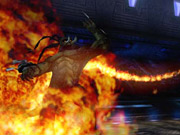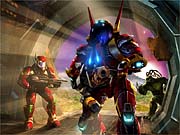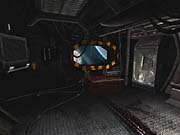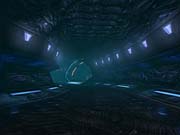Unreal II Preview
We've got the first details on the upcoming sequel to the original Unreal.
Who says that id Software is the king of first-person shooters? With the 1998 release of Unreal, Epic Games (and Digital Extremes) fell into favor with a huge number of action gamers, and when Unreal Tournament came out the following year, Epic Games gained even more fans who were looking for more than what Quake III Arena was offering. Fans of Unreal will have something even bigger to look forward to in 2002, when Infogrames will release the latest game in the first-person shooter series: Unreal II. The game, which will officially be announced by Infogrames later this week, is currently in development at Legend Entertainment and not at Epic Games, surprisingly. The two companies have been working together for almost five years now, and their collaboration has resulted in a couple of projects, one of which was the critically acclaimed Wheel of Time, an action game based on the works of author Robert Jordan. This dynamic duo will continue its collaboration for Unreal II; according to Legend Entertainment Studio head Mike Verdu, Epic is handling development on the new 3D engine while Legend is taking on the responsibility of shaping the actual game. While specifics of the game are still a closely guarded secret, Verdu was able to give us a few details about Unreal II.

Unreal II is based on the same universe as Unreal, but it doesn't take place on the same planet nor does it involve any of the characters from the original game. In fact, the only constant between the two games will be the return of the deadly Skaarj predators. You'll play the role of a Terran Colonial Authority Frontier Marshal who is in charge of keeping the peace in a desolate and quiet region of space that slowly but surely is being colonized by humans. Verdu describes your character as a "24th-century equivalent of a sheriff in the Old West." Your patrol ship is called the Atlantis, a rusty 50-year-old craft that's on its last legs, so to speak. You share the Atlantis with a crew of three others: Aida, who is your female intelligence officer; an engineer who maintains the ship's armory; and a navigation officer, who pilots the Atlantis. The game starts out on a day like any other: quiet, mundane, and uneventful. When it is discovered that seven planets in the area are home to seven ancient artifacts, the entire region is suddenly thrust into a series of battles between five alien factions, your own military's troops, and warriors from numerous mercenary armies. It seems as though every living creature in the universe is after these seven relics. Soon after the fighting starts, you take it upon yourself to find the artifacts before they fall into the wrong hands. Verdu wouldn't say what the importance of these artifacts is, but the single-player campaign of Unreal II will have you hopping from one planet to the next in hopes of finding these relics and unlocking their secrets before anyone else does.

Beyond that, little else is known about the game's plot. We do know that you'll encounter a wide variety of alien species like the shian warrior, a floating crablike creature that resembles the Invid from Robotech fiction, and izarian hunters, which have six wicked weapons for limbs and razor-sharp teeth. Additionally, you'll also run into mercenaries of varying strengths--some will don medium armor while others will be wearing heavy suits with massive energy weapons. The game's 13 missions will take place across 25 distinct levels that include ancient alien ruins, underground caverns, the surface of a volcanic world, a dense rainforest, an industrial city, and an enemy starship. In all, there will be 10 unique environments in Unreal II, each with its own look and feel.
Other Details

The story will progress through cutscenes that are generated using the game's 3D engine. According to Verdu, most of these cutscenes will be composed of dialogue that your character will have with the NPCs like your ship's crew, although you'll also deal with others throughout your adventures on the seven planets. "The thing that will impress people about the game's story is not necessarily the high concept," explains Verdu. "I really am hoping that the gameworld and the characters we're creating for the crew will come alive for the player. To a certain extent, the world is as much a star as the characters. The environment and game's situations are very much a part of the story. And we're putting a huge amount of work into the details that will make the player's ship and the worlds he visits seem real...The magic will be in the details."
One of the more interesting aspects of Unreal II will be the way the game handles character interaction. Instead of canned conversation, or choosing from a predetermined text tree, your dialogue commands will involve more than just hitting the action key repeatedly. For example, your response time to a question that was asked by an NPC will determine what kind of response you, in turn, will receive. If you take too long to reply to a question, that person can get upset or simply walk away in disappointment. You can also interrupt a conversation between two people or bring a third person into an existing conversation that you're having with someone else. Verdu says that implementing the conversation mechanism in Unreal II this way will lead to shorter, but much more interactive, dialogue.

Of course, the biggest improvement over the original Unreal will be in the game's new graphics engine. To bring Unreal II to life, the programmers at Epic and the designers at Legend have given the Unreal engine a complete makeover. For starters, the polygon count in the environment and character models has been increased tenfold, thanks in large part to the technology's new mesh renderer and hardware brushes. The terrain system has also been improved to handle expansive areas, and the character animations and blending now use a new skeletal animation system that lets the animators create complex scripts for all the 3D models and then blend them on the fly. Additionally, the new engine allows for detailed facial expressions on the human models, which should go a long way toward conveying emotion and infusing the game with even more character than was previously possible in any Unreal-engine game. Legend is also paying special attention to Unreal II's multiplayer component. Verdu says that several popular modes will be available in the game--modes like deathmatch, team deathmatch, capture the flag, and last man standing. Unreal II will also feature a brand-new multiplayer game type that, aside from calling it "very exciting," Verdu is keeping quiet about.
The Unreal II team at Legend Entertainment is 19 strong, and it includes several external contractors. Jeremy Soule, who has composed musical scores for Total Annihilation and Icewind Dale in the past, will be writing the music for Unreal II, and Tommy Tallarico will be handling the game's sound effects. Unreal II has been in development for about a year now, and Infogrames plans on showing an early build of the game behind closed doors at this year's E3 in Los Angeles. We'll have more details on this exciting sequel in the coming months. Stay tuned.
Got a news tip or want to contact us directly? Email news@gamespot.com
Join the conversation